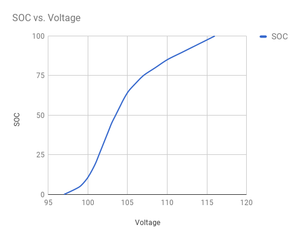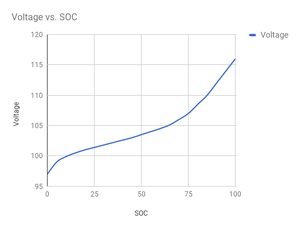Difference between revisions of "State of Charge"
From Unofficial Zero Manual
BrianTRice (talk | contribs) (cleanup and update) |
(No difference)
|
Latest revision as of 00:25, 1 July 2020
State of Charge is a calculation meant to help estimate remaining energy in the Battery.
- Concepts
- SoC is a porportional representation; a percentage (fraction), so it is only applicable with a known total or max.
- Riders all have experienced different ranges under different temperatures, various environmental conditions etc.
- So full is really a subjective term, like asking When is a balloon full? Before it pops? But if you fill it with cold air then move to a warm environment, it pops.
- Paraphrase of ElectricZen's explanation
- SoC is most easily calibrated using the battery pack's voltage at rest or near rest.
This is a rough guide to correlating at rest battery voltage to the state of charge.
- There is respectable unofficial guidance that this curve varies as the pack ages over its lifetime.
- These figures are determined from some selection of owners with logs, with minimal experimental controls.
| Your mileage may literally vary! |
| VPack | VCell | SoC |
|---|---|---|
| 115.9…116.2 | 4.14…4.15 | 100 |
| 113.9…114.24 | 4.07…4.08 | 95 |
| 112.0…112.3 | 4.00…4.01 | 90 |
| 109.76…110.8 | 3.92…3.96 | 85 |
| 108.36 | 3.87 | 80 |
| 106.96 | 3.82 | 75 |
| 105.56 | 3.77 | 70 |
| 104.16 | 3.72 | 65 |
| 103.04 | 3.68 | 60 |
| 101.92 | 3.64 | 55 |
| 101.36 | 3.62 | 50 |
| 100.80 | 3.60 | 45 |
| 99.68 | 3.56 | 40 |
| 99.12 | 3.54 | 35 |
| 98.56 | 3.52 | 30 |
| 98.00 | 3.5 | 25 |
| 97.16 | 3.47 | 20 |
| 96.60 | 3.45 | 15 |
| 96.04 | 3.43 | 10 |
| 95.76 | 3.42 | 5 |
| 95.20 | 3.4 | 0 |
- (Obsolete) SoC Indications per protomech
- Before Zero removed pack capacity readout from the mobile app, there were some corroborating indications available:
- The app appeared to simply show kWh using Zero's max capacity rating, i.e. present voltage times present amp hours.
- The voltage and amp-hours were likely to be correct, but the kWh readout was a rough guide at best.
- The percentage reading adjusted to the estimated pack maximum over time, so as the pack aged, the reported Ah and kWh readout would decrease, but not the maximum percentage.
- Variance across Battery Pack Years
- The sensor equipment measuring current and temperature for the battery pack improve over the years, impacting SoC indication.
- 2017 model year bikes appear to have an increased range of current sensor calibration quality, improving that year's estimations.
- Cell behavior also varies over the years, generally improving in robustness.
- One can find multiple complaints of going into limp-home mode at 5-15% from 2014 SR owners, for example.
- Variance by riding conditions
- Cell discharge is an electrochemical process that depends on the cells' physical conditions.
- The resistance of the cell (which should be low) increases with environmental factors like temperature.
- This results in reduced performance, since the resistance lowers the terminal voltage of the cells and the overall battery pack.
- At low SoC values, SoC might drop considerably once the BMS observes low terminal voltage as an indirect result of low temperatures or a cell imbalance.
- The lowest-performing cell becomes the limiting factor in pack performance at low voltage / SoC, and Zero does not provide indications to help you anticipate or diagnose this.

